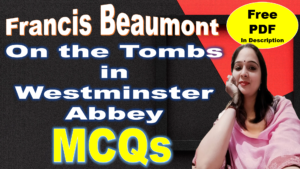The Tyger by William Blake Questions and Answers
Very Short Answer Questions
Q: Who is the author of “The Tyger”?
A: The author of “The Tyger” is William Blake.
Q: In which collection does “The Tyger” appear?
A: “The Tyger” appears in the collection “Songs of Experience”.
Q: What is the form of “The Tyger”?
A: “The Tyger” is a lyric poem consisting of six quatrains.
Q: What is the rhyme scheme of “The Tyger”?
A: The rhyme scheme of “The Tyger” is AABB.
Q: What does the Tyger symbolize in the poem?
A: The Tyger symbolizes the fierce force in the world, which is both terrifying and beautiful.
Q: What is the central question of the poem?
A: The central question of the poem is who or what could create such a fearsome creature as the Tyger.
Q: What does the Lamb symbolize in the poem?
A: The Lamb symbolizes innocence and gentleness.
Q: What does the speaker wonder about in the second stanza?
A: The speaker wonders where the Tyger’s fiery eyes were created.
Q: What does the speaker question in the third stanza?
A: The speaker questions what kind of strength and skill could create the Tyger’s heart.
Q: What imagery is used in the fourth stanza?
A: The fourth stanza uses blacksmithing imagery to describe the creation of the Tyger’s brain.
Q: What celestial event does the speaker describe in the fifth stanza?
A: The speaker describes a celestial reaction to the creation of the Tyger in the fifth stanza.
Q: What does the speaker ask about the creator in the fifth stanza?
A: The speaker asks if the creator of the Tyger also made the Lamb.
Q: How does the poem end?
A: The poem ends with a repetition of the first stanza.
Q: What is the tone of the poem?
A: The tone of the poem is one of awe and wonder, mixed with a sense of fear and mystery.
Q: What themes does the poem explore?
A: The poem explores themes of divine creation, beauty, and the dichotomy of good and evil.
Q: What does the “burning bright” in the first line refer to?
A: The “burning bright” refers to the shining, almost fiery appearance of the tiger.
Q: What does the “fearful symmetry” in the first stanza refer to?
A: The “fearful symmetry” refers to the tiger’s ferocious yet beautiful form.
Q: What does the “dread hand” and “dread feet” in the third stanza suggest? A: The “dread hand” and “dread feet” suggest a powerful and perhaps terrifying creator.
Q: What does the “deadly terrors” in the fourth stanza refer to?
A: The “deadly terrors” refer to the tiger’s ferocious capabilities.
Q: What does the speaker mean by “Did he who made the Lamb make thee?” in the fifth stanza?
A: The speaker is questioning whether the same divine being that created the gentle Lamb also created the fierce Tyger.
Short Answer Questions
Q: What is the significance of the Tyger’s creation in the poem?
A: The Tyger’s creation is significant as it represents the process of bringing something into existence that is both beautiful and terrifying. The speaker marvels at the Tyger’s form and questions what kind of divine being could create such a creature. This reflects on the paradox of creation – that it can produce both beauty and terror.
Q: How does Blake use contrast in “The Tyger”?
A: Blake uses contrast in “The Tyger” to highlight the dichotomy of good and evil in the world. The Tyger, a symbol of ferocity and power, is contrasted with the Lamb, a symbol of innocence and gentleness. This contrast raises questions about the nature of the divine and the complexity of the universe.
Q: What is the role of rhetorical questions in the poem?
A: The rhetorical questions in “The Tyger” serve to express the speaker’s awe and wonder at the Tyger’s creation. They also invite the reader to ponder the same questions, engaging them in the speaker’s contemplation of the divine and the nature of creation.
Q: How does the poem reflect the Romantic era’s emphasis on emotion and individualism?
A: “The Tyger” reflects the Romantic era’s emphasis on emotion through its evocative language and vivid imagery, which convey a sense of awe and fear. The poem’s focus on the individual experience of the speaker, who grapples with profound questions about the nature of the divine, also aligns with the Romantic emphasis on individualism.
Q: How does the poem use imagery to convey its themes?
A: The poem uses vivid and fiery imagery to convey its themes. The Tyger is described as “burning bright” in the forests of the night, an image that captures its fearsome power and beauty. The imagery of the stars throwing down their spears and watering heaven with their tears suggests a cosmic reaction to the Tyger’s creation, underscoring the poem’s exploration of the divine.
Q: What does the repetition of the first stanza at the end of the poem signify? A: The repetition of the first stanza at the end of the poem brings the poem full circle, emphasizing the unanswered question of the Tyger’s creation. It also serves to reinforce the poem’s central themes and heighten the sense of mystery and awe.
Q: How does the poem explore the theme of creation?
A: The poem explores the theme of creation through its questioning of the Tyger’s origins. The speaker wonders about the divine being who could create such a fearsome creature, and contrasts this with the creation of the gentle Lamb. This reflects on the complexity and paradox of creation.
Q: What is the significance of the blacksmith imagery in the poem?
A: The blacksmith imagery in the poem serves to illustrate the process of creation. The speaker uses the metaphor of a blacksmith forging the Tyger to convey the idea of a powerful creator shaping the Tyger under intense heat and pressure. This imagery underscores the theme of creation and the power of the divine.
Q: How does the poem reflect Blake’s views on religion and the divine?
A: The poem reflects Blake’s views on religion and the divine through its exploration of the nature of the divine being who could create both the Tyger and the Lamb. This suggests a complex and multifaceted view of the divine, capable of creating both beauty and terror. It also reflects Blake’s questioning of traditional religious beliefs.
Q: What is the impact of the poem’s simple language and complex subject matter?
A: The impact of the poem’s simple language and complex subject matter is to make profound and philosophical questions about the nature of the divine and the paradox of creation accessible and engaging. The simple language draws in the reader, while the complex subject matter invites deeper contemplation and interpretation.










